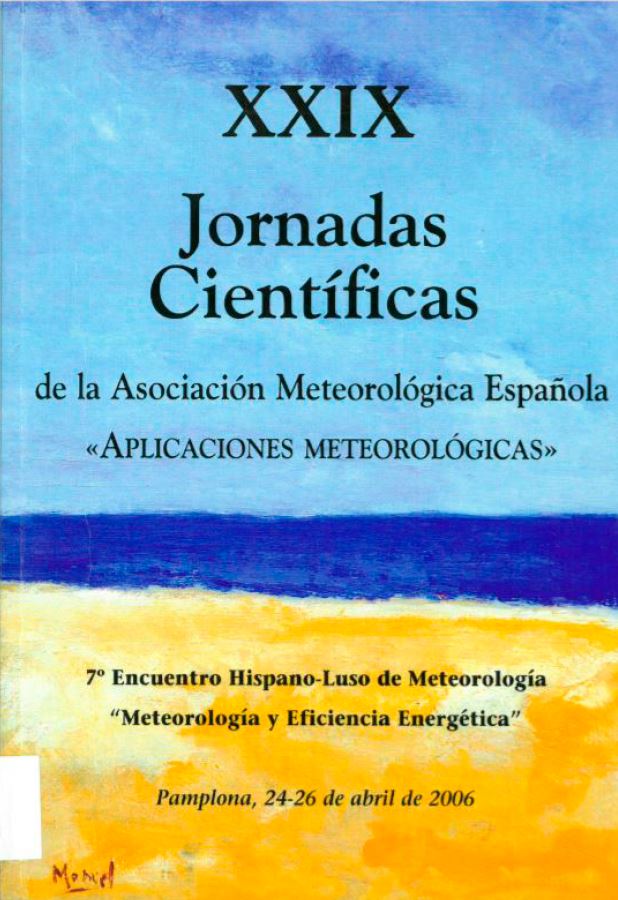ESTIMACIÓN DE LA RADIACIÓN GLOBAL DIARIA EN ZONAS DE TOPOGRAFÍA COMPLEJA UTILIZANDO MODELOS DIGITALES DEL TERRENO E IMÁGENES DE METEOSAT: COMPARACIÓN DE LOS RESULTADOS
Resumen
El conocimiento de la radiación solar es muy importante a la hora de diseñar sistemas solares tanto térmicos, como fotovoltaicos. En escalas locales, la topografía es el factor más importante modulador de la radiación solar en superficie. En este trabajo se estima la radiación global diaria en todo tipo de condiciones de cielo, en zonas que presentan una topografía compleja. Para ello se utilizará una metodología basada en Modelos Digitales del Terreno (MDT) a partir, por un lado, de medidas piranométricas y, por otro, de imágenes de satélite. Se pone de manifiesto que la aplicación del MDT sobre medidas piranométricas proporciona mejores resultados que las estimaciones a partir de imágenes de satélite, si bien la precisión obtenida (RMSE & MBE) es del mismo orden de magnitud en ambos casos.Citas
Beyer, H. G., Costanzo, C. and Heinemann, D., 1996. Modifications of the Heliosat procedure for irradiance estimates from satellite images. Solar Energy 56, 207-212.
Beyer, H. G., Hammer, A. and Heinemann, D., 1997. Satellite-derived irradiance statistics for Africa. Solar Energy 59, 233-240.
Cano, D., 1982. Etude de l'ennuagement par analyse de séquences d'images de satellite. Application à l'évaluation du rayonnement solaire global au sol. Thèse 3ème Cycle, École Nationale Supérieure des Télécommunications, Paris (France).
Cano, D., Monget, J. M., Albuisson, M., Guillard, H., et al. 1986. A method for the determination of the global solar radiation from meteorological satellite data. Solar Energy 37, 31-39.
Collares-Pereira, M. y Rabl, A., 1979. The average distribution of solar radiation-correlations between diffuse and hemispherical and between daily and hourly insolation values. Solar Energy 22, 155-164.
Diabaté, L., Demarcq, H., Michaud-Regas, N. and Wald, L., 1988. Estimating incident solar radiation at the surface from images of the Earth transmitted by geostationary satellites: the Heliosat Project. International Journal of Solar Energy 5, 261-278
Diabaté, L.,1989. Determination du rayonnement solairea l´aide d´images satelitaires. Tesis Doctoral. L´Ecole Nationales Superieure des Mines de Paris
Dribssa, E., Cogliani, E., Lavagno, E. and Petrarca, S., 1999. A modification of the Heliosat method to improve its performance. Solar Energy 65, 369-377.
Dubayah and Van Katwijk, 1992. The topographic distribution of annual incoming solar radiation in the rio grand River basin. Geophys Res. Leter, 19, 22312234.
Dubayah and Rich, 1995. Topographic solar models for GIS. Int J. Geographical Information System, 4, 405-419.
ESRA, 2000. The European solar radiation atlas. Vol. 1: Fundamentals and maps. Editado por: Scharmer, K. and Reif, J. Les Presses de l'Ecole des Mines, Paris (France).
EUMETSAT, 2002. Meteosat High resolution image dissemination. Technical description. EUMETSAT, Darmstadt (Germany).
EUMETSAT. Meteosat VIS channel calibration information (v 23.11.05). www page EUMETSAT. http://www.eumetsat.de.
Fu, P and Rich, P., 1999. Desingn and implementation of the Solar Analyst: an Arciew extension for modelling solar radiation at landscape scales. Proceedings of 19th Annual ESRI User Conference, San Diego, USA.
Fu and Rich, 2000. Ageometric solar radiation models and its applications in the agricultura and forestry. Proceedings of Second International Conference on Geoespatial Information in Agriculture and Forestry, Lake Buena vista.
Lopez, G., Rubio, M. A. y Batlles, F. J., 2000. Estimation of hourly direct normal from measured global solar irradiance in Spain. Renewable Energy 21, 175-186.
Perez, R., Seals, R. and Zelenka, A., 1997. Comparing satellite remote sensing and ground network measurements for the production of site/time specific irradiance data. Solar Energy 60, 89-96.
Rigollier, C., Lefèvre, M. and Wald, L., 2004. The method Heliosat-2 for deriving shortwave solar radiation from satellite images. Solar Energy 77, 159-169.
Rigollier, C. and Wald, L., 1998. Using METEOSAT images to map the solar radiation: improvement of the Heliosat method. Ponencias de: 9th Conference on Satellite Meteorology and Oceanography, Paris (France). pp. 432-433.
Schulze-Kegel, D. and Heidt, F. D., 1996. Mapping of global radiation with METEOSAT. Solar Energy 58, 77-90.
Zarzalejo, L. F., 2006. Irradiancia solar global horaria a partir de imágenes de satélite. Serie: Colección Documentos CIEMAT. Editorial CIEMAT, Madrid (España).
Zelenka, A., Pérez, R., Seals, R., Renné, D., 1999. Effective accuracy of satellite-dereved hourly irradiances. Theoretical ans Applied Climatology, 62, 199-207

